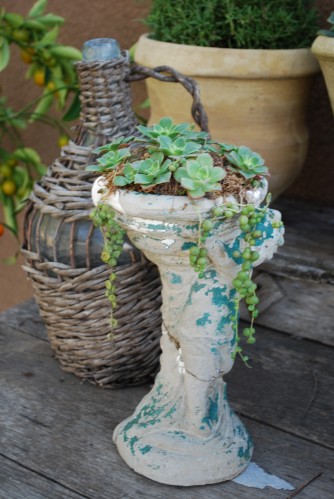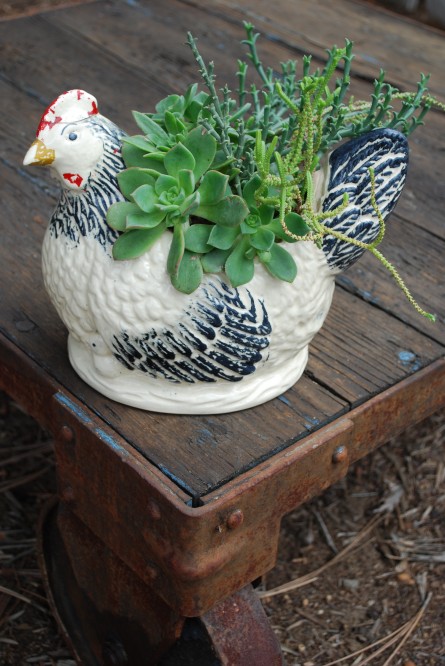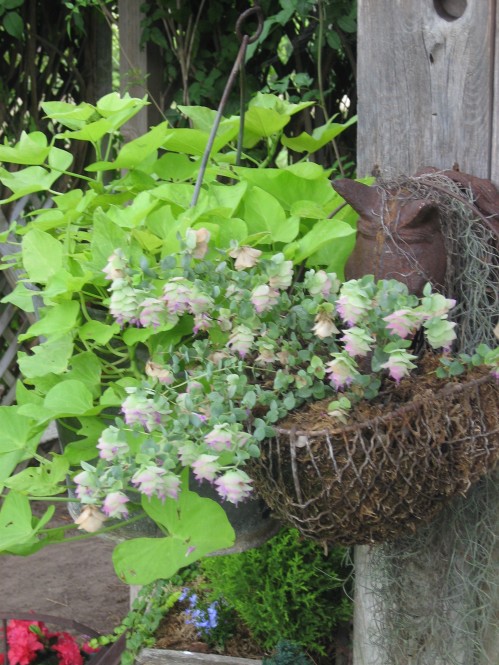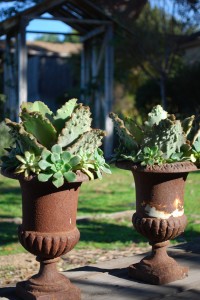 I love finding great vintage containers with a past. They have a history, the intrigue of previous owners, time-worn patina, and usually multiple imperfections. All of which create an incredible charm and uniqueness.
I love finding great vintage containers with a past. They have a history, the intrigue of previous owners, time-worn patina, and usually multiple imperfections. All of which create an incredible charm and uniqueness.
One of my favorite pieces in my garden is this tiny charming cherub statuary, diligently overseeing her thriving succulent planting of echeveria and string of pearls. She might also hold a candle glowing with a soft romantic light, or some sweetly-scented dried lavender. I have a lot of cherubs in my garden, for a touch of femininity, and maybe to evoke a certain mystique.
This sweet little cherub was once a fecund green, now muted and disappearing in places. She was broken at one time, and someone cared enough to mend her. I purchased her back east, so she has journeyed far. She definitely has a past, and now she has a present and an ongoing future.
Don't overlook these types of vintage container treasures as they can add oodles to your garden charm with their simplicity and sheer survival. Best places to find these vintage container treasures, is often where it is most reasonable. Seek out your local flea markets, thrift stores, garage sales, alley dumpsters (no kidding), barn sales, and favorite garden antique shops.
Please comment if you have a vintage container treasure that makes a statement in your garden? You believe that one person's discard, can be another persons' treasure?

 Vintage chicken planter cackles with character, and begs to be potted with succulent plumage. Round and rosette-like, I use my perennial favorite succulent, echeveria, planted at my hen's shoulder and back. Similiar to a perfectly shaped fleur-de-lis, is the handsome green, slightly uncommon ice plant relative, Smicrostigma viride. The chartreuse green notched strands, with a mind of their own, are Crassula mucosa, or Watch Chain succulent (formerly Crassula lycopoidioides). One couldn't ask for better plumage, that keeps on growing.
Vintage chicken planter cackles with character, and begs to be potted with succulent plumage. Round and rosette-like, I use my perennial favorite succulent, echeveria, planted at my hen's shoulder and back. Similiar to a perfectly shaped fleur-de-lis, is the handsome green, slightly uncommon ice plant relative, Smicrostigma viride. The chartreuse green notched strands, with a mind of their own, are Crassula mucosa, or Watch Chain succulent (formerly Crassula lycopoidioides). One couldn't ask for better plumage, that keeps on growing. If you are a gardener, chances are you like to grow herbs, too. One of the most beautiful herbs I have ever grown is the ornamental oregano, Kent Beauty, Origanum rotundifolium. While most oregano varieties are grown for their culinary use, Kent Beauty and a few other ornamental oregano varieties are not, and in fact, have no taste at all. Ornamental oregano are best used for their beauty in gardens, borders, and especially containers.
If you are a gardener, chances are you like to grow herbs, too. One of the most beautiful herbs I have ever grown is the ornamental oregano, Kent Beauty, Origanum rotundifolium. While most oregano varieties are grown for their culinary use, Kent Beauty and a few other ornamental oregano varieties are not, and in fact, have no taste at all. Ornamental oregano are best used for their beauty in gardens, borders, and especially containers.

